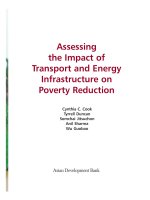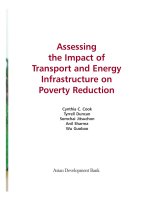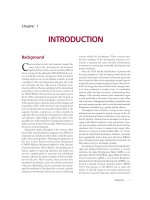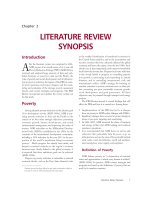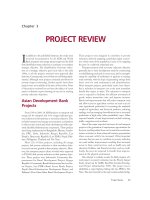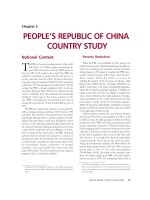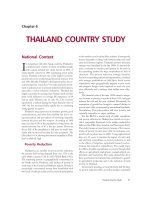The impact of credit and liquidity risk on financial stability at vietnamese commercial banks
Bạn đang xem bản rút gọn của tài liệu. Xem và tải ngay bản đầy đủ của tài liệu tại đây (2.06 MB, 86 trang )
STATE BANK OF VIETNAM
MINISTRY OF EDUCATION & TRAINING
HO CHI MINH UNIVERSITY OF BANKING
TRUONG THANH NGUYEN
THE IMPACT OF CREDIT AND LIQUIDITY RISK ON FINANCIAL
STABILITY AT VIETNAMESE COMMERCIAL BANKS
GRADUATION THESIS
THE MAJOR: FINANCE – BANKING
CODE: 7 34 02 01
HO CHI MINH CITY, YEAR 2022
STATE BANK OF VIETNAM
MINISTRY OF EDUCATION & TRAINING
HO CHI MINH UNIVERSITY OF BANKING
STUDENT: TRUONG THANH NGUYEN
STUDENT ID: 050606180265
CLASS: HQ6-GE10
THE IMPACT OF CREDIT AND LIQUIDITY RISK ON FINANCIAL
STABILITY AT VIETNAMESE COMMERCIAL BANKS
GRADUATION THESIS
THE MAJOR: FINANCE – BANKING
CODE: 7 34 02 01
SUPERVISOR
Dr. LE HA DIEM CHI
HO CHI MINH CITY, YEAR 2022
i
ABSTRACT
The thesis " the impact of the credit risk and liquidity risk on financial bank stability
of Vietnamese commercial banks in 2011 – 2021" including non-performing loans
ratio (NPLR ); Loan to total assets ratio (TLA); Loan loss provision ( LLP );
Leverage (LEV); Loan to total deposit ratio (LDR); Size of the bank (SIZE); Return
on equity (ROE); Capital adequacy ratio (CAP); Growth Revenue (IGR);
Economic growth rate (GDP) and Inflation rate (INF).
The research topic applies Pooled-OLS, FEM, and REM models. However, the
results show that the research model encounters autocorrelation and variable
variance, so the author continues applying the model. FGLS model to overcome the
research model. Then, the author applies the GMM model to test the endogenous
phenomenon occurring in the research model and receives high-accuracy research
results. Hence, the author receives the analysis results from the GMM model as the
final result.
Research on the impact of credit and liquidity risk on financial stability at
Vietnamese commercial banks for 2011-2021, in which the group of internal factors
that harm the bank's stability is NPLR, ROE, CAP, and LEV. The factors LDR,
TLA, and LLP, have a positive impact on the financial stability of the bank. The
remaining variables are not statistically significant in the model not statistically
significant in the model.
ii
COMMITMENT
I hereby declare that the thesis " the impact of credit and liquidity risk on financial
stability at vietnamese commercial banks" is the author's research work, and the
research results received are truthful. The information, data, and content cited are
collected by the author from many different sources, have high reliability, and are
cited in the reference section.
Ho Chi Minh City,
2022
Author
Truong Thanh Nguyen
iii
ACKNOWLEDGMENT
First of all, I would like to thank the teachers who are lecturers at Banking
University of Ho Chi Minh City, the school's Board of Directors for creating
favorable conditions for teaching and guiding me with a lot of knowledge about
banking and teaching. taught both soft skills and moral training during my time
here.
I would like to thank and send kind words to the person who guided me in the
process of completing the thesis - Dr. Le Ha Diem Chi, who oriented, guided,
helped and encouraged me throughout the process of completing the thesis. into a
research thesis.
Finally, I would like to express my gratitude to my family and friends around for
helping and encouraging me when I faced difficulties in the process of completing
my thesis, and at the same time, I would like to sincerely thank my colleagues in the
organization. my authority. They gave me a lot of practical knowledge while
working here.
iv
TABLE OF CONTENTS
ABSTRACT ................................................................................................................i
COMMITMENT ...................................................................................................... ii
ACKNOWLEDGMENT ........................................................................................ iii
LIST OF ACRONYMS ......................................................................................... vii
LIST OF TABLES ................................................................................................ viii
LIST OF GRAPHICS ..............................................................................................ix
CHAPTER 1. INTRODUCTION TO THE RESEARCH TOPIC ....................... 1
1.1. Reason for Research .......................................................................................1
1.2. Objective of study ...........................................................................................1
1.2.1. General objective ....................................................................................1
1.2.2. Specific objective ....................................................................................1
1.3. Research question ...........................................................................................2
1.4. Subject and scope of the study .......................................................................2
1.4.1. Subject of the study ................................................................................2
1.4.2. Scope of the study ...................................................................................2
1.5. Contributions ..................................................................................................3
1.6 Structure of reasearch .....................................................................................3
SUMMARY OF THE CHAPTER 1 ........................................................................ 5
CHAPTER 2. REVIEW OF THE LITERATURE ................................................ 6
2.1. Overview of basic concept ..............................................................................6
2.1.1. The concept of credit risk ......................................................................6
v
2.1.2 The concept of liquidity risk ...................................................................6
2.2 The relationship of credit risk and liquidity risk..........................................7
2.3. An overview of previous studies ....................................................................8
SUMMARY OF THE CHAPTER 2 ...................................................................... 10
CHAPTER 3 RESEARCH MODEL AND METHODOLOGY ......................... 11
3.1. Reasearch model ...........................................................................................11
3.2 Mesurement of research variables ...............................................................12
3.2.1. Z- Score ( Bank Stability Ratio) ..........................................................12
3.2.2. LDR (Loan to deposit ratio) ................................................................12
3.2.3. NPLR (Non-Performing Loans Ratio) ...............................................12
3.2.4. IGR ( Revenue growth rate) ...............................................................12
3.2.5. SIZE (Bank size) ...................................................................................13
3.2.6. ROE (Return on equity).......................................................................13
3.2.7. TLA ( Total Loan to Asset ) .................................................................13
3.2.8. CAP ( Capital adequacy ratio) ............................................................13
3.2.9. LLP ( Loan loss provisions) .................................................................13
3.2.10. LEV (Leverage ) .................................................................................14
3.2.11. INF (Inflation) .....................................................................................14
3.2.12. GDP (Economic growth) ....................................................................14
3.3. Research hypothesis......................................................................................14
3.4. Research data and research method ...........................................................18
3.4.1. Research data ........................................................................................18
3.4.2 Research Methods .................................................................................18
vi
SUMMARY OF THE CHAPTER 3 ..................................................................... 21
CHAPTER 4: RESEARCH RESULTS AND DISSCUSSION ........................... 22
4.1. Descriptive statistical analysis. ....................................................................22
4.2 Correlation Matrix ........................................................................................24
4.3. Estimating the regression model and testing the regression hypotheses. 26
4.3.2. Compare the FEM model and the REM model. ................................29
4.3.3. Check for multicollinearity..................................................................29
4.3.4. Check for autocorrelation....................................................................30
4.4. Overcoming the research model and GMM regression model method. ..32
4.5. Summarize and discuss research result ......................................................34
SUMMARY OF THE CHAPTER 4 ...................................................................... 42
CHAPTER 5. CONCLUSION AND RECOMMENDATION............................ 43
5.1. Conclusion of the result obtain from the research ....................................43
5.2. Recommendation on financial stability of bank ........................................43
5.2.1 Solutions to increase business efficiency .............................................43
5.2.2.Credit growth solutions.........................................................................44
5.2.3. Solutions to ensure capital safety. .......................................................45
5.3. Limitations of the topic ................................................................................45
5.4. Further research directions .........................................................................46
SUMMARY OF THE CHAPTER 5 ...................................................................... 46
REFERENCES ........................................................................................................ 47
APPENDIX .............................................................................................................. 51
vii
LIST OF ACRONYMS
No
Acronym
Meaning
1
OLS
Pooled OLS regression model
2
FEM
Fixed Effects Model
3
REM
Random Effect Model
4
FGLS
Feasible generalized least squares model
5
GMM
Generalized Method of Moments
viii
LIST OF TABLES
Table 3. 1. Statistics of expected signs of variables in the model ............................17
Table 4. 1. Statistics of variables used in the research model ...................................22
Table 4. 2 Correlation Matrix....................................................................................25
Table 4. 3 Result of Pooldes – OLS Model ..............................................................27
Table 4. 4 Result of Fixed Effects Model .................................................................28
Table 4. 5 Result of the Hausman test ......................................................................29
Table 4. 6 Results of multicollinearity test ...............................................................30
Table 4. 7 Wooldridge test results.............................................................................31
Table 4. 8 Breusch and Pagan Lagrangian test result ...............................................31
Table 4. 9 GMM test result .......................................................................................32
Table 4. 10 Synthesize the results from the model analysis using STATA software.
...................................................................................................................................34
ix
LIST OF GRAPHICS
Graphic 4. 1. Relationship between Z-Score & LDR ...............................................36
Graphic 4. 2 Relationship between Z-Score & NPLR ..............................................37
Graphic 4. 3 Relationship between Z-Score & TLA ................................................38
Graphic 4. 4 Relationship between Z-Score & ROE ................................................39
Graphic 4. 5 Relationship between Z-Score & CAP ................................................40
Graphic 4. 6 Relationship between Z-Score & LLP .................................................41
Graphic 4. 7 Relationship between Z-Score & LEV ................................................42
1
CHAPTER 1. INTRODUCTION TO THE RESEARCH TOPIC
1.1. Reason for Research
The commercial banking system in Vietnam has a core role in developing the
country's economy. In the past, our country and the world were heavily influenced
by the 2008 economic-financial system. This crisis has almost engulfed the entire
world economy. From the situation in the world, we can see the importance of the
banking system to a country.
For financial stability in a banking system, risk management is an issue that
needs to be focused on in a country. Credit risk and liquidity risk are one of the
risks that have the most impact on the stability of the banking system. In Vietnam,
research papers on the influence of credit risk and liquidity risk on the banking
system's strength have been quite long and not suitable for the current economic
situation of the country. Therefore, this article will show the impact of liquidity and
credit risk on the stability of the current banking system.
1.2. Objective of study
1.2.1. General objective
The overall objective of the thesis is to study and analyze the impacts of credit risk
and liquidity risk on the Vietnamese commercial banking system.
1.2.2. Specific objective
The specific objectives of this study are:
● Determining the factors of liquidity risk and credit risk affecting the
stability of Vietnam's commercial banking system
● Identify model from previous studies
● Determining the level of impact of factors on the financial stability of the
Vietnamese banking system
● Propose solutions and recommendations to commercial banks in Vietnam,
to improve financial stability in commercial banking systems and limit risks
2
affecting the financial stability of banks. commercial goods from credit and
liquidity risks
1.3. Research question
To achieve the stated research objectives, the thesis focuses on answering the
following research questions:
● What factors affect the liquidity risk and credit risk of Vietnamese
commercial banks?
● How factors of financial risk and liquidity risk affect the financial stability of
the commercial banking system ?
● The direction of impact of credit and liquidity risk on financial stability of
Vietnam's commercial banking system ?
● Which model and method to determine the impact of factors in liquidity risk
and credit risk on the financial stability of Vietnam's commercial banking
system?
● What solutions to balance financial stability in Vietnam's commercial
banking system?
1.4. Subject and scope of the study
1.4.1. Subject of the study
The object of the research in the essay is the impact of credit and liquidity risk
on financial stability at vietnamese commercial banks
1.4.2. Scope of the study
● Scope of spatial research: The study was conducted based on data
collected from 27 commercial banks in Vietnam.
● Scope of time research: The study was conducted based on data collected
in the period from 2011 to 2021.
3
1.5. Contributions
The research results in this thesis can be used as a reference for scholars,
administrators, policy makers, etc. to contribute to improving the efficiency of
banking operations, reducing risks and improving liquidity for Vietnam's
commercial banking system, thus contributing to giving a different perspective on
the problem to easily identify risks and take appropriate measures.
1.6 Structure of reasearch
Chapter 1: INTRODUCTION TO THE RESEARCH TOPIC
This chapter presents an overview of the research paper including the
following contents: reasons for choosing the topic; research problem; objectives of
the study; research question; object and scope of the study; research significance;
research paper structure.
Chapter 2: LITERATURE REVIEW
In this chapter, the study will first present the theoretical basis of liquidity and
liquidity risk, then present the factors affecting liquidity risk, and finally summarize
the models of liquidity risk. Previous research related to this topic.
Chapter 3: RESEARCH MODEL AND METHODOLOGY
Based on the content presented in chapter 2, chapter 3 will focus on presenting
the content related to the research model, research variables, research data, research
methods, and processes to achieve results for which the aim of the study is
concerned.
Chapter 4: RESEARCH RESULTS AND DISCUSSION
Chapter 4 focuses on two topics: descriptive statistics of the research variables
and testing of the research model, thereby obtaining research results and analyzing
the correlation relationship, direction, and level of influence the impact of variables
on the liquidity risk of Vietnamese commercial banks.
4
Chapter 5: CONCLUSIONS AND RECOMMENDATIONS
After collecting the research results from chapter 4, chapter 5 will re-evaluate
the research results, give comments on the limitations of the study (if any), and
finally make recommendations to improve the efficiency of liquidity operations for
Vietnamese commercial banks.
5.2. Thematic structure detail
The detailed layout of the research paper is expected to be designed for each
specific chapter, section, and subsection as follows:
CHAPTER 1: INTRODUCTION TO THE RESEARCH TOPIC
1.1. Research problem
1.2. The study's objectives
1.3. Question of research
1.4. Object and scope of the study
1.5 Contributions
1.6 Structure of research
CHAPTER 2: REVIEW OF THE LITERATURE
2.1. Overview of basic concept
2.1.1 The concept of the risk of liquidity
2.1.2. The concept of the risk of credit
2.2. The relationship of credit risk and liquidity risk
2.3. An overview of previous studies
CHAPTER 3: RESEARCH MODELS AND METHODS
3.1. The research model and the research hypothesis
5
3.2. Measurement of research variables
3.3. Research Methods
CHAPTER 4: RESEARCH RESULTS AND DISCUSSION
4.1. Descriptive statistics
4.2. Correlation analysis
4.3. Multicollinearity test
4.4. Estimating the regression model by Pooled OLS, FEM, and REM methods.
4.5. Model selection test
4.6. Test of variance and autocorrelation
4.7. Research results
4.8. Discussing research results
CHAPTER 5: CONCLUSIONS AND RECOMMENDATIONS
5.1. Conclusion of the result obtain from the research
5.2. Recommendation on financial stability of bank
5.3. Limitations of the topic
5.4. Further research directions
SUMMARY OF THE CHAPTER 1
In chapter 1, the author introduces an overview of the selected topic and presents
issues surrounding the research topic, including the reasons for choosing the
subject, research objectives, research questions for the case, The object and scope of
the research, the structure of the topic and the contributions of the research topic.
6
CHAPTER 2. REVIEW OF THE LITERATURE
2.1. Overview of basic concept
2.1.1. The concept of credit risk
According to the State Bank of Vietnam Credit risk in banking activities is the
possibility of loss to the bank due to customers' failure to perform or inability to
perform their obligations as committed (2005).
Credit risk management is critical to measuring and optimizing the profitability of
banks. The long-term success of any banking institution depends on an effective
system of ensuring the repayment of the borrower's loans, which is critical in
dealing with asymmetric information problems, while at the same time reducing the
loan loss. (Basel, 1999)
To minimize loan loss as well as credit risk, banks need to have an effective credit
risk management system (Santomero, 1997); (Basel, 1999). Because of the
asymmetric information between banks and borrowers, banks must have a system in
place to ensure that they can analyze and assess default risk without their
knowledge.
The bank's business may face difficulties when the quality of loans deteriorates
slightly. Poor loan quality originates from the information processing mechanism
(Liukisila, 1996) and then increases at the loan approval, monitoring and control
stages. This problem is exacerbated when guidelines for credit risk management in
terms of policies, strategies and procedures related to credit processing do not exist
or are weak or incomplete.
2.1.2 The concept of liquidity risk
The concept of liquidity in the economic literature refers to the ability of a financial
agent to exchange its existing assets for goods and services or other assets.
Liquidity and solvency are natural twin banks, often indistinguishable. An illiquid
bank can quickly become insolvent and an insolvent bank. When the Basel
7
Committee on Banking Supervision was first established was founded in 1975, its
President, George Blunden, at its first meeting, vowed to try to strengthen the
capital and liquidity operations of the central international commercial banks. The
downward trend in banks' capital ratios was halted and then reversed by Basel I.
The benefit of doing so is evident in most banks' more vital capital positions. In the
current context.
(GOODHART, 2008).
Some researchers have found a significant relationship between the two variables.
They argue that reducing liquidity risk positively impacts the bank performance,
(Bourke, 1989); (Lartey, 2013); (Étienne Bordeleau and Christopher Graham ,
2010) . However, some people find the opposite true (Konadu, 2009). Furthermore,
some studies found no meaningful relationship between the two variables
(Lamberg, S., & Vålming, S. (2009)); (Li, 2007)). The difference in results in all of
these studies is due to different effects across regions and over different periods.
2.2 The relationship of credit risk and liquidity risk.
According to (Dermine, 1986) liquidity risk is seen as a profit-lowering cost. A loan
default augments liquidity risk because of the lowered cash inflow and
depreciations it triggers. Based on the theory financial intermediation (Bryant,
1980); (Douglas W. Diamond and Philip H. Dybvig, 1983) and the industrial
organization approach to banking, which features in the Monti-Klein model of
banking (Eliezer Z., Prisman, Myron B.Slovin, Marie E.Sushka, 1986), there is a
relationship between liquidity and credit risk. According to (Samartın
́ , 2003)) and
(Rajkamal Iyer, Manju Puri, 2012), based on these models, show that risky bank
assets trigger bank shocks. Based on these models, liquidity and credit risk should
be positively related and jointly contribute to bank instability.
(ITAY GOLDSTEIN and ADY PAUZNER, 2005) researchers evaluate from a
theoretical point of view, the results show that liquidity at the level that affects
credit risk.
8
(Diamond, Douglas W. and Raghuram G. Rajan, 2005) show a positive relationship
between liquidity and credit risk. They clarified that if loans financed too many
economic projects, the bank would not be able to meet depositors' demands. So
these depositors will claim their money back if these assets depreciate. This implies
that liquidity risk and credit risk increase at the same time.
The relationship between the two risks is positive and contributes to bank
instability. The idea of a positive relationship focuses on times of financial crisis
(Cevik et al., 2012).
The theoretical literature of intermediate finance modeled essentially by (Bryant,
1980), (Diamond, Douglas W. and Raghuram G. Rajan, 2005). Based on these
models, liquidity and credit risks are positively related. They simultaneously
contribute to bank instability.
2.3. An overview of previous studies
The recent financial crisis that led to banks' collapse has negatively impacted the
real economy. Therefore, a paying particular attention to the consequences of
economic instability on established economies (Agnello, L., & Sousa, R.M., 2012).
The impact of credit and liquidity risk on bank stability has been the subject of
several academic works (Acharya and Mora, 2013); (Adusei, 2015); (Tijani Amara,
Mohamed Mabrouki, 2019); (Imbierowicz and Rauch, 2014); (Wassim RAJHI,
Slim A. HASSAIRI, 2013), etc.). Their results were inconsistent. Some studies have
shown that these two risks have destabilized banks. On the other hand, the second
group of authors emphasizes the positive impact of these two risks on the stability
and sustainability of the bank. The third research group shows the neutral effect of
credit and liquidity risk on bank stability, which depends on other factors.
(Imbierowicz and Rauch, 2014) analyzed the relationship between liquidity risk and
credit risk and their overall impact on the probability of bank default for a sample of
4,300 US commercial banks over the period. 1998–2010 period.
. In addition,
9
their interaction's effect depends on the bank's overall risk profile and can both
increase or decrease the risk of bank failure.
For (Acharya and Mora, 2013), the role of banks as liquidity providers is a powerful
guarantor during the 2008 financial crisis. They have demonstrated that the banks
that failed in the recent financial crisis had liquidity problems. Banks fail to attract
deposits by offering high-interest rates, which is one of their main results.
Indirectly, the results indicate that the presence of both liquidity risk and credit risk
can push banks to bankruptcy.
(Fu X., Lin Y., Philip M., 2014)
focus on the competitiveness and financial
stability of Asian-Pacific banks. The authors use data from 14 Asia-Pacific
economies from 2003 to 2009 to investigate the impact of banking competition,
national concentration, regulation, and institutions on the fragility of banks.
Individual banks by calculating the bank's probability of bankruptcy and z-score
[11, P. 64–77]. Research shows that greater concentration contributes to Higher
financial volatility, and lower market power also causes banking risks as
macroeconomic conditions, different banking characteristics, regulations, and
institutions are governed.
In the study of (Anh L.N.Q, Quoc N.Q, Thanh L.T.P, 2020), they showed that the
stability of banks positively impacts equity on assets, bank size, and loan-to-money
ratio. Meanwhile, the most apparent finding emerging from this study is that net
profit margin is the most appropriate criterion to assess the stability of banking
operations lower bank stability.
(David (Dongheon) Shin and Baeho Kim, 2015), the authors studied the impact of
credit and liquidity risk on borrower default verification for Nigerian banks.
Research using Pearson correlation also shows that the effects of liquidity risk and
signal risk lead to bank debt verification.
10
(Vo Xuan Vinh, Mai Xuan Đuc, 2020) showed that the bank's size, operating cost
management efficiency and revenue growth have an impact on the bank's stability.
Banks with high total assets will operate stably and efficiently. Therefore, banks
need to manage asset quality well, gradually increase the proportion of non-credit
operating income to minimize the risk of loss of total assets.
SUMMARY OF THE CHAPTER 2
In chapter 2, the author provides a theoretical basis for liquidity risk and credit risk
and the impact of the above risks on the stability of commercial banks to have a
better view of the risk and how liquidity and credit risk affect the stability of the
Bank. At the same time, it can be seen how liquidity risk and credit risk interact.
Finally, the author summarizes the results from previous studies to build the
research model that will be implemented in the next chapter.
11
CHAPTER 3 RESEARCH MODEL AND METHODOLOGY
3.1. Reasearch model
Based on previous studies of many authors on credit risk and liquidity risk,
along with the impact of risks on the stability of the domestic and foreign
commercial banking system in each period. Different periods from which to
propose a separate research model for the financial stability of Vietnam's
commercial banking system in the period from 2010 to 2021, the following is the
author's research model:
Z-Scoreit = β0 + β1 LDRit + β2NPLRit + β3IGRit + β4 TLAit +β5 SIZEit +
β6 ROEit + β7 CAPit + β8LLPit + β9LEVit+ β10GDPt+ β11INFt+ ɛit
In there:
● Dependent variables
o Z-Scoreit : bank stability of the commercial banking ( i ) at the time (
t)
● Independent variables
o LDRit: Loan to deposit ratio of the commercial bank (i) at the time (t)
o NPLRit: Non-Performing Loan Ratio of the commericial bank(i) at the
time (t)
o IGRit: Revenue growth of the commercial bank (i) at the time (t)
o TLAit: Total Loan Assets of the commercial bank (i) at the time (t)
o SIZEit: Bank size of the commercial bank (i) at the time (t)
o ROEit: Return on equity of the commercial bank (i) at the time (t)
o CAPit: Capital adequacy ratio of the commercial bank (i) at the time
(t)
o
LLPit: The ratio of loan loss provisions of the commercial bank (i) at
the time (t)
12
o LEVit: Leverage of the commercial bank (i) at the time (t)
o INFt: Inflation rate at the time (t)
o GDPt : Economic growth at the time (t)
3.2 Mesurement of research variables
3.2.1. Z- Score ( Bank Stability Ratio)
A bank's financial stability is usually measured by the z-score. The calculation of zscore was proposed by (Laeven, L. & Levine, R., 2009) and (Martin Čihák, Heiko
Hesse, 2007). The higher the z-Score, the more stable the bank because it is related
to the inverse of the bank's insolvency ratio.
𝑍 − 𝑆𝑐𝑜𝑟𝑒 =
𝑅𝑒𝑡𝑢𝑟𝑛 𝑜𝑛 𝑎𝑠𝑠𝑒𝑡 𝑟𝑎𝑡𝑖𝑜 − 𝐶𝑎𝑝𝑖𝑡𝑎𝑙 𝑡𝑜 𝑎𝑠𝑠𝑒𝑡 𝑟𝑎𝑡𝑖𝑜
𝑆𝑡𝑎𝑛𝑑𝑎𝑟𝑑 𝑑𝑒𝑣𝑖𝑡𝑎𝑡𝑖𝑜𝑛 𝑅𝑒𝑡𝑢𝑟𝑛 𝑜𝑛 𝑎𝑠𝑠𝑒𝑡 𝑟𝑎𝑡𝑖𝑜
3.2.2. LDR (Loan to deposit ratio)
The ratio of total outstanding loans divided by total deposits assesses the extent to
which customer loans are financed by customer deposits. This variable can reflect
the liquidity position of the bank.
𝐿𝐷𝑅 =
𝑇𝑜𝑡𝑎𝑙 𝑙𝑜𝑎𝑛𝑠
𝑇𝑜𝑎𝑙 𝑠ℎ𝑜𝑟𝑡 − 𝑡𝑒𝑟𝑚 𝑑𝑒𝑝𝑜𝑠𝑖𝑡𝑠
3.2.3. NPLR (Non-Performing Loans Ratio)
This ratio high indicates that debt is likely to lose capital high bank. So this variable
has the value The higher the bank, the more stable decrease and vice versa.
𝑁𝑃𝐿𝑅 =
𝑁𝑜𝑛 − 𝑃𝑒𝑟𝑓𝑜𝑟𝑚𝑖𝑛𝑔 𝐿𝑜𝑎𝑛𝑠
𝑇𝑜𝑡𝑎𝑙 𝐿𝑜𝑎𝑛𝑠
3.2.4. IGR ( Revenue growth rate)
Revenue growth is the rate of increase growth of the bank's total revenue for the
year current compared to the previous year.
IGR =
𝑅𝐺𝑛 –𝑅𝐺(𝑛−1)
𝑅𝐺(𝑛−1)
13
3.2.5. SIZE (Bank size)
Bank size is measured by taking the logarithm of the bank's total assets.
SIZE = Logarithm(Total assets)
3.2.6. ROE (Return on equity)
This ratio reflects the efficiency of the bank's management in using equity, is
calculated as after-tax return on equity, a measure of profitability per dollar of
equity.
𝑃𝑟𝑜𝑓𝑖𝑡 𝑎𝑓𝑡𝑒𝑟 𝑡𝑎𝑥
ROE = 𝑇𝑜𝑡𝑎𝑙 𝑒𝑞𝑢𝑖𝑡𝑦
3.2.7. TLA ( Total Loan to Asset )
Banks often focus on using capital sources in traditional activities of lending.
Ordinary loans have low liquidity; Therefore, large and unpredictable withdrawals
are possible leading to bank insolvency.
𝑇𝐿𝐴 =
𝑇𝑜𝑡𝑎𝑙 𝐿𝑜𝑎𝑛𝑠
𝑇𝑜𝑡𝑎𝑙 𝐴𝑠𝑠𝑒𝑡𝑠
3.2.8. CAP ( Capital adequacy ratio)
Capital adequacy ratio is one of the most important issues in the banking sector
today efficiency and stability of the bank. The capital adequacy ratio is calculated
using the formula of total equity to total assets.
𝐶𝐴𝑃 =
𝑇𝑜𝑡𝑎𝑙 𝑒𝑞𝑢𝑖𝑡𝑦
𝑇𝑜𝑡𝑎𝑙 𝑎𝑠𝑠𝑒𝑡𝑠
3.2.9. LLP ( Loan loss provisions)
LLP (Loan Loss Provision) is the ratio of loan loss provision and net interest
income, used to measure the quality and size of investment in risky assets by
managers.
.𝐿𝐿𝑃 =
𝐿𝑜𝑎𝑛 𝑙𝑜𝑠𝑠 𝑃𝑟𝑜𝑣𝑖𝑠𝑖𝑜𝑛𝑠+𝑅𝑒𝑣𝑒𝑛𝑢𝑒
𝑇𝑜𝑡𝑎𝑙 𝑙𝑜𝑎𝑛𝑠
14
3.2.10. LEV (Leverage )
Leverage is a combination of liabilities and equity in operating the fianancial
policies of a bank. It will thrive in bussiness with a higher proportion of liabilites
than equity. Conversely, it will be low when the proportion of liabilities is smaller
than the proportion of equity.
𝐿𝐸𝑉 =
𝑇ℎ𝑒 𝑟𝑎𝑡𝑖𝑜 𝑜𝑓 𝑑𝑒𝑏𝑡
𝑇𝑜𝑡𝑎𝑙 𝐸𝑞𝑢𝑖𝑡𝑦
3.2.11. INF (Inflation)
The variable inflation rate is calculated by the inflation rate of the year of
observation, showing the trend of the economy and serving as an indicator for the
State Bank to adjust economic policy in line with the economic trend in that period.
3.2.12. GDP (Economic growth)
The economic growth index is one of the macro factors affecting all business
activities across all economic sectors, calculated by the annual economic growth
index.
3.3. Research hypothesis
LDR (Loans-to-Deposits Ratio): The ratio of total outstanding loans divided by
total deposits assesses how customer deposits finance customer loans. This variable
can reflect a bank's liquidity position (Dong et al. 2014). The higher the value of the
LDR, the higher the bank's liquidity risk, so the lower the bank's stability.
H1: LDR is inversely related to the financial stability of the Vietnamese banking
system.
Non-Performing Loans Ratio (NPL): negatively affects the stability of the bank,
NPL can increase the risk of bankruptcy. Indeed, higher credit risk increases
bankruptcy. In other words, higher credit risk is associated with a greater
probability of bank failure.( 2017)


